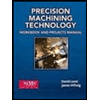Problem 2. Turning Consider Step 2 (Turn Shoulder) in machining the flashlight handle (Figure 2). STEP 1: CUT TO LENGTH STEP 2: TURN SHOULDER 1.0 0s00 2.000 Figure 2. Turning step for Problem 2. i) Calculate the (1) cutting time (in s), (2) the material removal rate (in in3 /s or mm3 /s) for this cut, assuming you remove all of the material with one pass (i.e., depth of cut d = (1"-0.6")/2 = 0.2"), and (3) the power (hp or W) required for this turning operation: Consider the following scenarios: Feed (f) in/rev Rotational Speed (0) in RPM Cutting Time MRR Power 0.02 1000 ? ? ? 0.025 900 ? ? ? 0.03 800 ? ? ?
Problem 2. Turning Consider Step 2 (Turn Shoulder) in machining the flashlight handle (Figure 2). STEP 1: CUT TO LENGTH STEP 2: TURN SHOULDER 1.0 0s00 2.000 Figure 2. Turning step for Problem 2. i) Calculate the (1) cutting time (in s), (2) the material removal rate (in in3 /s or mm3 /s) for this cut, assuming you remove all of the material with one pass (i.e., depth of cut d = (1"-0.6")/2 = 0.2"), and (3) the power (hp or W) required for this turning operation: Consider the following scenarios: Feed (f) in/rev Rotational Speed (0) in RPM Cutting Time MRR Power 0.02 1000 ? ? ? 0.025 900 ? ? ? 0.03 800 ? ? ?
Precision Machining Technology (MindTap Course List)
2nd Edition
ISBN:9781285444543
Author:Peter J. Hoffman, Eric S. Hopewell, Brian Janes
Publisher:Peter J. Hoffman, Eric S. Hopewell, Brian Janes
Chapter4: Drill Press
Section4.3: Drill Press Operations
Problem 2RQ: Briefly define the term cutting speed.
Related questions
Question

Transcribed Image Text:Problem 2. Turning Consider Step 2 (Turn Shoulder) in machining the flashlight handle (Figure 2).
STEP 1: CUT TO LENGTH
STEP 2: TURN SHOULDER
0.600
1.0"
3.000
-0.440
Figure 2. Turning step for Problem 2.
i) Calculate the (1) cutting time (in s), (2) the material removal rate (in in3 /s or mm3/s) for this
cut, assuming you remove all of the material with one pass (i.e., depth of cut d = (1"-0.6")/2 =
0.2"), and (3) the power (hp or W) required for this turning operation: Consider the following
scenarios:
Feed (f) in/rev
Rotational Speed
Cutting Time
MRR
Power
(n) in RPM
0.02
1000
?
?
?
0.025
900
?
?
?
0.03
800
?
?
?
1
j) What changes could you make to the process if you needed to decrease the power
requirement?
Expert Solution
This question has been solved!
Explore an expertly crafted, step-by-step solution for a thorough understanding of key concepts.
This is a popular solution!
Trending now
This is a popular solution!
Step by step
Solved in 5 steps with 5 images

Knowledge Booster
Learn more about
Need a deep-dive on the concept behind this application? Look no further. Learn more about this topic, mechanical-engineering and related others by exploring similar questions and additional content below.Recommended textbooks for you

Precision Machining Technology (MindTap Course Li…
Mechanical Engineering
ISBN:
9781285444543
Author:
Peter J. Hoffman, Eric S. Hopewell, Brian Janes
Publisher:
Cengage Learning

Precision Machining Technology (MindTap Course Li…
Mechanical Engineering
ISBN:
9781285444543
Author:
Peter J. Hoffman, Eric S. Hopewell, Brian Janes
Publisher:
Cengage Learning